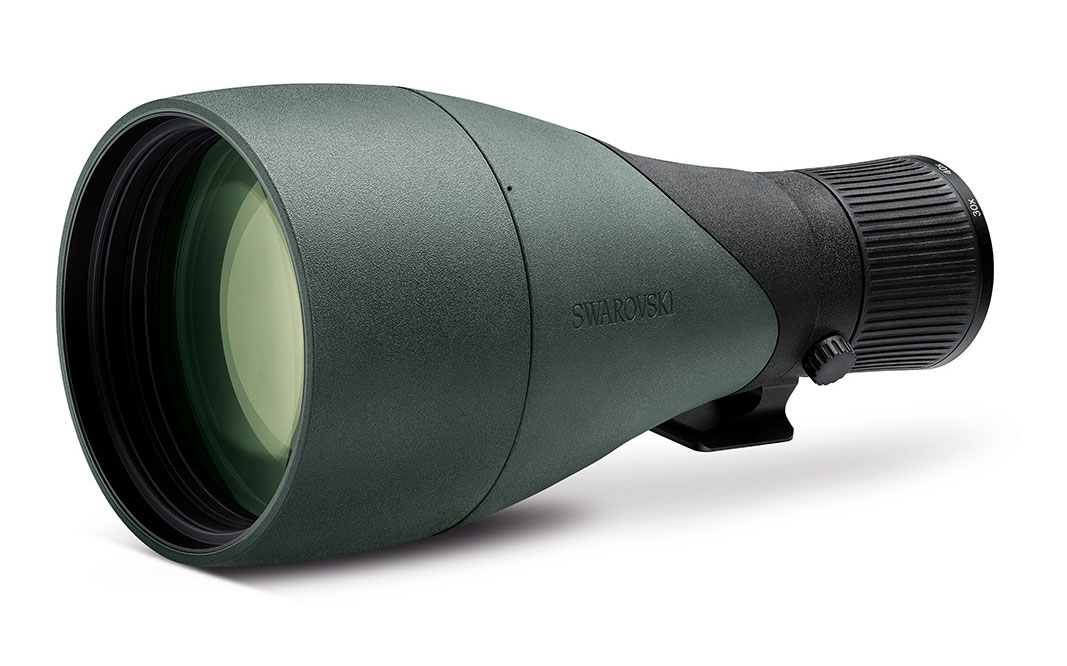Swarovski 115 mm ATX/STX/BTX objective module
It's been eight years since Swarovski Optik launched its revolutionary ATX/STX modular telescope system that enabled the scope to be separated into two parts, significantly increasing its portability, as well as introducing interchangeability of objective lenses.
Prior to October 2020, those objective modules comprised 65 mm, 85 mm and 95 mm versions, the first two of which delivered a magnification range of 25-60x, while the largest produced a remarkable zoom range of 30-70x. Then, however, enter the 115 mm.
The leap to this next size up represents much more than birding optics on a grandiose scale. Its magnification and field of view are the same as the existing 95 mm objective module, but the larger objective lens diameter delivers more than 45% additional light to the eye of the observer. It is designed to be a boon in low light conditions, as well as providing a higher resolution in comparison to the other objectives in the range.
Make no mistake, though, the 115 is conspicuous – its relative enormity matched only by the range of quizzical to admiring looks I received while putting it to use in the field.
Its appearance conforms to that of the other objectives. The whole of the aluminium body – bar the focusing ring – is wrapped in 'Swarovski green' rubber armour, including the lens hood. The latter pulls out smartly to offer the glass a generous 70 mm of protection from the elements.
At the opposite end sits a deep-milled, smooth-turning focusing ring. In front of this is a ring-mounted, rotating tripod foot.
Along with its large size comes weight. The tripod foot is Manfrotto compatible – which means a quick release plate (QRP) is not necessary when used with certain tripod models – but its heaviness would better justify its use in conjunction with an ARCA-style tripod head with a sliding QRP to act as a counterbalance, preventing the unit tilting forwards. This did happen in use, even when the eyepiece module was connected, hence my switch to an ARCA set-up.
One further weight-related word of warning: because of the torque produced by the larger size and extra weight, users need to make sure that any QRP fitted to the unit is equipped with an anti-rotation pin to prevent the scope working loose and becoming detached from the tripod.
The good news is that, despite the combined weight of the two modules equalling just shy of 3 kg, a 'heavy-duty' tripod isn't needed to support the unit. Furthermore, although I was aware of it, I was able to accommodate almost 1.2 kg more weight than usual while carrying my tripod over my shoulder without any real discomfort.
The 115 was designed to improve light gathering and image quality, as well as offering high-end magnification. So, did it pass muster?
The 115 focuses down to 4.8 m, even at 70x magnification, and I was able to see a full field of view at both ends of the range and with the twist-out eyepiece both closed down and fully extended. Potential users should be aware, though, that with the magnification range starting at 30x, subjects at close range may be more difficult to locate if they are used to operating with lower starting magnifications.
The image, when compared directly with an 85 mm ATX, appeared slightly warmer, although contrast and brightness were both high and the image was pleasingly sharp across its entirety and across the full range of magnification. There was no difficulty in obtaining clarity and sharpness at the highest magnification, where focusing was easily accomplished.
Colours were spot on. It didn't matter whether I was watching Common Crossbills in the subdued lighting of coniferous woodland, wildfowl on late autumn, open floodwater or roosting gulls at twilight, the 115 provided the required clarity and detail in order make identification possible and the experience enjoyable. For example, using a hastily ‘home-crafted’ adapter, I was still able to obtain acceptably clear digiscoped images of both Caspian and Yellow-legged Gulls before the light finally faded into the darkness of a late November afternoon.
How many birders' armouries it will make its way into will principally be a function of cost and – importantly – weight, as it comes in at a full kilogram more than the 85 mm objective module, the latter probably constituting the popular choice at this point in time. The 115 does, however, deliver the goods to the very highest quality.
Further info
- Price: £2,370
- Size: 307 mm (440 mm with ATX eyepiece module)
- Weight: 2,100 g (2,910 g with ATX eyepiece module)
- Magnification range: 30-70x
- Field of view: 67 m at 1,000 m
- Light transmission: 90%
- Close focus: 4.8 m
- Gas-filled: yes
- Waterproof: yes
- Guarantee: 10 years
Verdict
+ Image sharp across entirety and across full range of magnification
+ Can see full field of view at both ends of magnification range
- Weighs a full kilogram more than 85 mm objective module
- Find out more about the ATX on the Swarovski Optik website.



